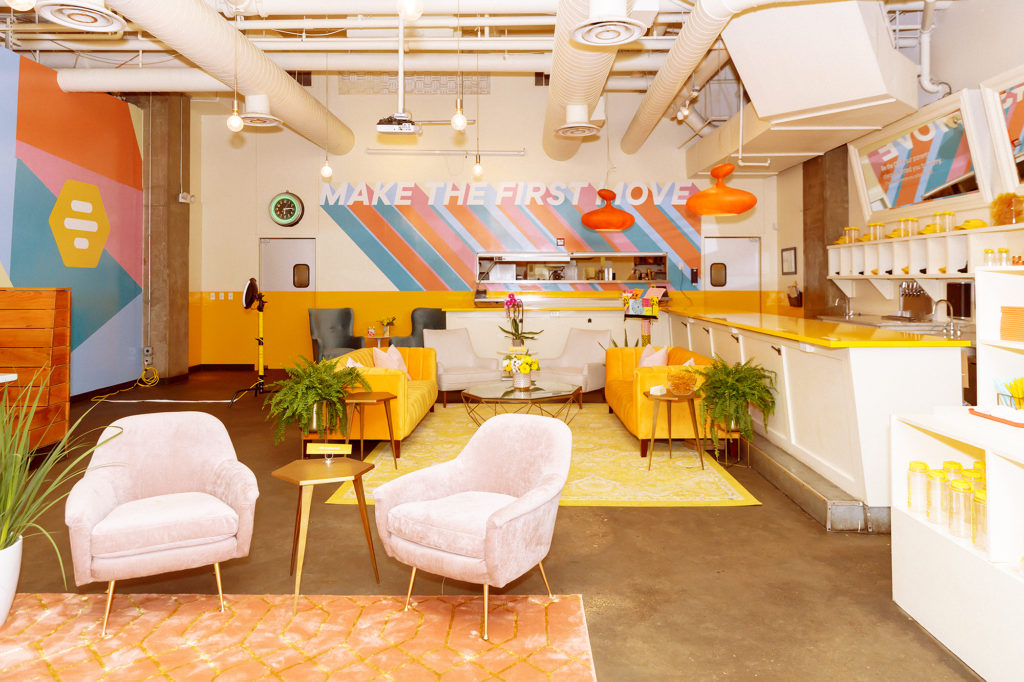Go behind the scenes of South By Southwest’s biggest activations with local experiential strategists.
By Courtney Runn, Photo by Laura Delacruz

During South by Southwest, Annie Thompson is at work by 6 a.m. and doesn’t leave until midnight or 1 a.m. As a live-event producer, the festival is one of her busiest weeks of the year.
This year, she produced Bumble’s Hive, a 10-day activation at Jo’s Coffee on Second Street. From yellow mugs to the brand’s signature candles and on-brand bathroom decals (“Don’t stall. Make the first move.”), every inch of the space was Bumble-fied. Guests could stop by all day for free coffee, mentoring sessions with the Bumble team and themed programming. Olivia Wilde even stopped by while in town for her Booksmart premiere.
“I am like an orchestra conductor,” Thompson says. “I don’t play a certain instrument, but I find the best musicians and I make sure they all play in sync and that it sounds really good.”
After working as a national-events manager for Google and developing and launching Google Fiber, Thompson decided to branch out with Pen + Prue Productions. She is currently the only employee with a set of consistent freelancers. Besides Bumble, she also worked with Icon’s 3-D labs for SXSW and is already planning the Hot Luck festival and ATX TV Festival.
Once on the fringes of the marketing and advertising industries, experiential marketing is now a staple for large brands. From food samples at Costco to the Oscar Mayer Wienermobile, offering customers an experience has long existed, but with the proliferation of social media, it is now expected.
SXSW is an experiential playground with brands competing for the most buzz. This year, Game of Thrones partnered with the American Red Cross to encourage fans to “bleed for the throne” and donate blood at elaborately themed activations. Wired teamed up with ADP to let guests literally shatter a glass ceiling in honor of International Women’s Day. The TV show Good Omens plastered the city in advertising, releasing characters into Austin proclaiming, “The end is nigh,” and creating a Garden of Earthly Delights with a tree procuring beer and wine, dogs playing hellhounds, a hair-braiding station and photo ops galore.
“Experiential is a part of the traditional media mix now,” Thompson says. “There really isn’t a huge brand that doesn’t engage people in a live capacity anymore because that’s kind of how consumers want to be talked to.”
Thompson says she starts planning for SXSW in early November and estimates that most brands can’t build activations for a cost of less than six figures. Some cost as much as $20 million. For the Bumble Hive, Thompson says the team started setting up at 9 p.m. March 5 and finished 48 hours later, at 9 p.m. March 7, the day before the festival began.
When developing a live experience, Thompson thinks of everything and usually hits on each of the five senses. At the Hive, there was a female-empowerment playlist pumping in the background. Most won’t even notice it, but each detail contributes to a truly immersive experience.
During SXSW panel Experiential is the New Viral: Get Yours, three event programmers from large brands discussed their strategies in creating activations and pop-ups. They agreed “the why” is the most important element of any successful event: Is the brand trying to sell product, generate fear of missing out or trend on social media?
Last year, Bumble created an elaborate event in East Austin for a few days. This year, Thompson says, the company decided to scale smaller and stay downtown for the full festival in hopes of more foot traffic. Each brand, she says, will have a different strategy to achieve different objectives.
While large-scale events like SXSW showcase the flair of experiential, this form of marketing is an effective tool year-round. Corina Frankie, founder of local marketing company Brand Besties, works with four full-time employees and an army of brand ambassadors and contractors to brainstorm and execute creative marketing solutions during SXSW and beyond. With past experience working with large brands like Moët Hennessy and Dr Pepper, she’s able to understand the perspective of the company and the consumer.
She charges $1,600 for a brainstorming session. Often, she finds large brands have the budget for activations but have no idea where to start. She essentially offers companies a blueprint for an individualized experience, leaving it up to them to produce it in-house or hire her team.
She’s currently working with Lydian Dental to execute an ongoing experience. The dental service provides services in Austin and Arizona, and partners with companies to bring pop-up dental care to the office. The service comes at a low price point for Lydian Dental, and its originality will likely help it stand out.
For Frankie, experiential marketing is all about creating “an actual connection with the person…[that]deepens the relationship.” After working in the industry for years, she’s finally seeing experiential marketing become commonplace and a more familiar term to consumers.
The metrics of experiential marketing can be challenging. It’s difficult to gage a feeling. But as the format becomes more popular, experiential strategists like Frankie and Thompson are finally seeing their industry become recognized as valid—and crucial.
“Experiential is here to stay,” Thompson says. “If the growth of this festival isn’t example enough of that, it should be the fact that it has spun off all these other live experiences.”


